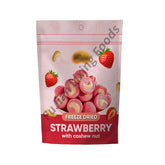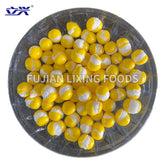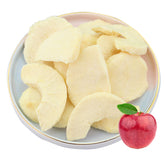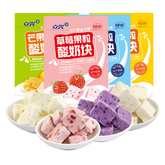Is freeze-dried fruit a Healthy food?
Today, the market offers an increasing variety of freeze-dried products, such as freeze-dried fruits, vegetables, and coffee, with freeze-dried fruits being the most common. But after processing, how much nutrition is left in these colorful, crispy fruits?
Ensuring Nutrient Retention
How are freeze-dried fruits made?
Step 1: Freezing
Fresh fruits are quickly frozen, creating many tiny ice crystals that prevent structural damage.
Step 2: Vacuuming
Air is removed, and pressure is lowered, placing the fruit in a vacuum state.
Step 3: Drying
Solid ice sublimates directly into vapor, drawing water out of the fruit. Through repeated cycles, the fruit gradually dries and becomes crispy.
Under the dual protection of vacuum and low temperature, freeze-drying cleverly avoids the nutrient loss that often occurs with traditional high-temperature drying methods. Though a small amount of water-soluble vitamins like vitamin C may be lost, most vitamins, minerals, and dietary fiber remain well-preserved. Antioxidants such as anthocyanins, flavonoids, and carotenoids are also fully retained.
Therefore, there’s no need to worry too much about nutrient loss in freeze-dried fruits.
Benefits for Specific Groups
Research indicates that consuming 26 grams of freeze-dried wild blueberry powder daily can help improve vascular function and cognitive abilities in healthy older adults. Studies have also found that freeze-dried berries like blueberries, blackberries, cranberries, and mulberries can help regulate gut microbiota and improve conditions like ulcerative colitis.
Compared to fresh fruits, freeze-dried fruits, due to their porous texture, are gentler on those with sensitive stomachs. Additionally, freeze-dried fruits that have no added sugar won’t spike blood sugar levels, making them a great choice for diabetics.
The portability of freeze-dried fruits also makes them an ideal snack for busy professionals looking for convenient nutrition.
However, freeze-dried fruits should not completely replace fresh fruits!
Adults should consume 200-350 grams of fruit daily. Freeze-dried fruits should be considered a supplement to fresh fruit, offering variety to your daily diet.
Because the drying process removes most of the water, concentrating sugars, it's important to consume freeze-dried fruits in moderation. Diabetics can opt for unsweetened or low-sugar varieties like blueberries, raspberries, strawberries, cranberries, peaches, and pineapples.
Additionally, pairing freeze-dried fruits with other healthy snacks like nuts and yogurt can help maintain a balanced and diverse diet.
It's important to distinguish between VF (Vacuum Fried) and freeze-dried fruits, as they differ in both their processing techniques and final product characteristics.
VF (Vacuum Fried) Fruits are made using a vacuum low-temperature oil bath dehydration process. The fruits are fried in edible oil under a vacuum, which removes moisture. However, this can result in a slightly harder texture, and the products may retain some oiliness. VF fruits also tend to have moderate rehydration properties, and their nutritional content can be significantly reduced during processing due to the exposure to heat and oil. This method often uses palm oil, potentially increasing fat intake, and may sometimes involve artificial additives.
Freeze-Dried Fruits, on the other hand, are produced through a vacuum freeze-drying process, where the fruits are first frozen, and then under vacuum conditions, ice is sublimated directly into vapor, leaving the fruit dehydrated without the use of heat or oil. This results in a crisp texture, strong rehydration ability, and minimal loss of nutritional value. Freeze-dried fruits maintain the original fruit’s color, flavor, structure, and nutrients, making them a healthier option. Freeze-dried products are typically free from added oils or artificial additives, making them lower in fat and overall healthier than VF fruits.
In terms of health, freeze-dried fruits are the better choice due to their lack of oils and additives, and their ability to retain the most nutrients from the original fresh fruit.















